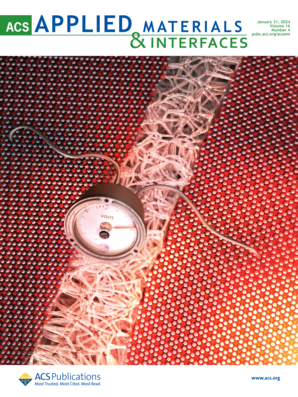利用飞秒激光诱导微图案和纳米形貌在氧化锆生物材料上裁剪细胞行为和抗菌性能
IF 8.3
2区 材料科学
Q1 MATERIALS SCIENCE, MULTIDISCIPLINARY
引用次数: 0
摘要
本研究探索了超短脉冲直接激光干涉图案(USP-DLIP)在氧化锆表面制造微图案的潜力,旨在增强其生物医学应用的细胞指导和抗菌性能。利用飞秒激光在3%摩尔氧化钇(3Y-TZP)稳定的四边形氧化锆多晶上制备了3和10 μm周期线性(L3和L10)和网格(G3和G10)图案。这些图案在保持最小表面损伤的情况下,在凹槽内具有激光诱导的高纵横比纳米形貌的均匀结构。通过地形引导和纳米地形诱导的细胞锚定,所有模式都显著增强了人间充质干细胞(hMSCs)的粘附、扩散和迁移。图案几何影响细胞形态和迁移:线性图案诱导沿凹槽的高伸长和排列,导致单向迁移,而网格结构促进双向排列的广泛细胞,促进双向迁移。铜绿假单胞菌(P. aeruginosa)(革兰氏阴性)和金黄色葡萄球菌(S. aureus)(革兰氏阳性)的抗菌评估显示细菌的反应依赖于细菌的大小。较低周期性的模式(L3和G3)显示出优越的抗菌性能,通过不同的机制减少细菌定植:机械捕获P. aeruginosa(减少25%)和破坏金黄色葡萄球菌的细菌聚集(减少30%)。hMSCs和细菌共培养实验证实,L3和G3表面有效地结合了增强细胞粘附和减少细菌定植,突出了USP-DLIP在开发多功能细胞指导和抗菌生物材料表面方面的潜力。本文章由计算机程序翻译,如有差异,请以英文原文为准。

Tailoring Cell Behavior and Antibacterial Properties on Zirconia Biomaterials through Femtosecond Laser-Induced Micropatterns and Nanotopography
This study explores the potential of ultrashort pulsed-direct laser interference patterning (USP-DLIP) to fabricate micropatterns on zirconia surfaces, aimed at enhancing their cell-instructive and antibacterial properties for biomedical applications. A femtosecond laser was employed to fabricate 3 and 10 μm periodic linear (L3 and L10) and grid (G3 and G10) patterns on tetragonal zirconia polycrystal stabilized with 3% molar yttrium oxide (3Y-TZP). The patterns exhibited homogeneous, high-aspect-ratio structures with laser-induced nanotopography within the grooves while maintaining minimal surface damage. All patterns significantly enhanced human mesenchymal stem cell (hMSCs) adhesion, spreading, and migration through topographical guidance and nanotopography-induced cell anchoring. Pattern geometry influenced cell morphology and migration: linear patterns induced high elongation and alignment along the grooves, leading to unidirectional migration, while grid structures promoted widespread cells with bidirectional alignment, promoting bidirectional migration. Antibacterial assessment using Pseudomonas aeruginosa (P. aeruginosa) (Gram-negative) and Staphylococcus aureus (S. aureus) (Gram-positive) revealed a size-dependent bacterial response. The patterns of lower periodicity (L3 and G3) showed superior antibacterial properties, reducing bacterial colonization through distinct mechanisms: mechanical trapping for P. aeruginosa (25% reduction) and disruption of bacterial aggregation for S. aureus (30% reduction). Coculture experiments with hMSCs and bacteria confirmed that L3 and G3 surfaces effectively combined enhanced cell adhesion with reduced bacterial colonization, highlighting the potential of USP-DLIP for developing multifunctional cell-instructive and antibacterial biomaterial surfaces.
求助全文
通过发布文献求助,成功后即可免费获取论文全文。
去求助
来源期刊

ACS Applied Materials & Interfaces
工程技术-材料科学:综合
CiteScore
16.00
自引率
6.30%
发文量
4978
审稿时长
1.8 months
期刊介绍:
ACS Applied Materials & Interfaces is a leading interdisciplinary journal that brings together chemists, engineers, physicists, and biologists to explore the development and utilization of newly-discovered materials and interfacial processes for specific applications. Our journal has experienced remarkable growth since its establishment in 2009, both in terms of the number of articles published and the impact of the research showcased. We are proud to foster a truly global community, with the majority of published articles originating from outside the United States, reflecting the rapid growth of applied research worldwide.
 求助内容:
求助内容: 应助结果提醒方式:
应助结果提醒方式:


